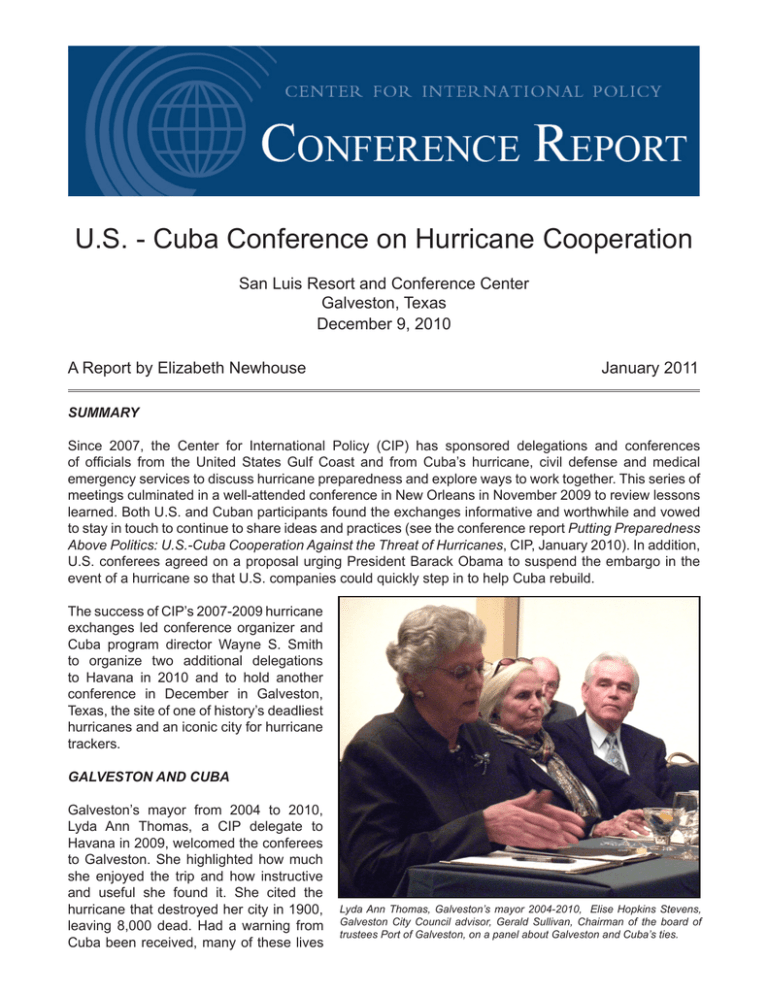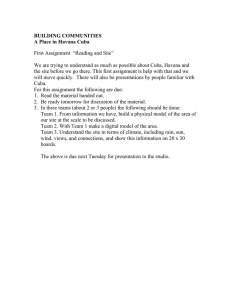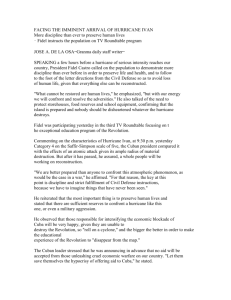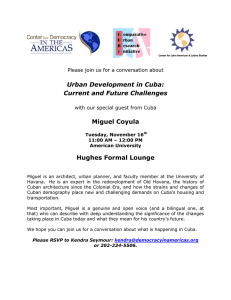
U.S. - Cuba Conference on Hurricane Cooperation
San Luis Resort and Conference Center
Galveston, Texas
December 9, 2010
A Report by Elizabeth Newhouse
January 2011
SUMMARY
Since 2007, the Center for International Policy (CIP) has sponsored delegations and conferences
of officials from the United States Gulf Coast and from Cuba’s hurricane, civil defense and medical
emergency services to discuss hurricane preparedness and explore ways to work together. This series of
meetings culminated in a well-attended conference in New Orleans in November 2009 to review lessons
learned. Both U.S. and Cuban participants found the exchanges informative and worthwhile and vowed
to stay in touch to continue to share ideas and practices (see the conference report Putting Preparedness
Above Politics: U.S.-Cuba Cooperation Against the Threat of Hurricanes, CIP, January 2010). In addition,
U.S. conferees agreed on a proposal urging President Barack Obama to suspend the embargo in the
event of a hurricane so that U.S. companies could quickly step in to help Cuba rebuild.
The success of CIP’s 2007-2009 hurricane
exchanges led conference organizer and
Cuba program director Wayne S. Smith
to organize two additional delegations
to Havana in 2010 and to hold another
conference in December in Galveston,
Texas, the site of one of history’s deadliest
hurricanes and an iconic city for hurricane
trackers.
GALVESTON AND CUBA
Galveston’s mayor from 2004 to 2010,
Lyda Ann Thomas, a CIP delegate to
Havana in 2009, welcomed the conferees
to Galveston. She highlighted how much
she enjoyed the trip and how instructive
and useful she found it. She cited the
hurricane that destroyed her city in 1900,
leaving 8,000 dead. Had a warning from
Cuba been received, many of these lives
Lyda Ann Thomas, Galveston’s mayor 2004-2010, Elise Hopkins Stevens,
Galveston City Council advisor, Gerald Sullivan, Chairman of the board of
trustees Port of Galveston, on a panel about Galveston and Cuba’s ties.
Conference Report
Center for International Policy
would have been saved. More than a century later, in 2008, Hurricane Ike followed the same path; this
time modern communications and early warnings gave the city time to prepare. Thomas added that in
pre-embargo days, ships bound for Cuba entered and left the port of Galveston, the city’s lifeline, several
times a week. “I hope those days will return,” she said.
Cuba’s disaster preparation greatly impressed Thomas during her trip. “Planning, planning, planning,” is
what it’s about, she said. Cuba’s bottom-up system, with neighborhoods mapped and the most vulnerable
people identified, inspired her to set up volunteer committees in Galveston to go door-to-door to assess
needs. As in Cuba, “medical personnel and social service agencies must be brought into preparedness
planning before a disaster.” After Hurricane Katrina, Thomas established a Mayors Preparedness Planning
group that held monthly meetings, consisting of all relevant organizations such as the Coast Guard,
Red Cross, medical and mental health agencies, and utilities companies. Today, Galveston is a regional
model for preparedness and response. “I know we learned from Cuba,” Thomas said, “and I hope the
relationship can continue well into the future.”
COOPERATION AND DIVERGENCE
In his introductory remarks, Wayne S. Smith noted that the virtual destruction of Galveston in 1900
dramatically highlighted the need for cooperation between the United States and Cuba, at least against
hurricanes. As vividly described in Erik Larson’s book, Isaac’s Storm, the giant storm struck Galveston on
September 8 without warning, wrecking the city and becoming the worst natural disaster in U.S. history.
How was there no warning? The Cuban meteorological service, one of the best in the world, had accurately
predicted the path and ferocity of the storm. However, Cuba was occupied by the United States at the
time, and the U.S. weather service had given instructions that the Cuban service was not to send out
international messages. As a result, the Cuban service was muzzled, and the U.S. service’s predictions that
the storm would turn north proved to
be incorrect.
This would not happen today.
Despite continuing strain in U.S.Cuban relations, relations between
the Cuban meteorological service
and the U.S. Hurricane Center in
Miami could not be better, as the
conference’s first panel made clear.
Lixion Avila of the Miami center,
born in Cuba, and Jose Rubiera,
chief of the early warning system at
the Cuban Meteorological Institute,
described their long friendship
and frequent exchanges. Miami’s
National Hurricane Center is the
regional forecasting center for the Robert Muse, Nick Kralj, Rep. Craig Eiland, Elizabeth Newhouse, Wayne Smith and
Randy Poindexter during the conference on U.S. - Cuba hurricane cooperation.
Atlantic basin and greatly depends
on input from Cuba. “Everyone at
the Hurricane Center, from the director on down, talks to Rubiera and his staff,” said Avila. On Sept. 15,
1875, Cuba issued the world’s first hurricane warning and the quality of its forecasting remains strong
today. “They have excellent data and radar and staff preparation,” noted Avila. He and Rubiera, together
with their Caribbean counterparts, have created a regional hurricane plan under the auspices of the
United Nations’ meteorological organization.
2
Conference Report
Center for International Policy
Modern-day cooperation between the United States and Cuba on hurricane tracking began in 1963 after
Hurricane Flora, and has continued ever since. However, due in part to the differing political systems,
the United States and Cuba dramatically diverge on their approaches toward planning, educating and
communicating with the public. In Cuba, the preparedness system is highly streamlined and integrated,
with strong coordination between the meteorological center, civil defense and state-run media. In the
United States, the system lacks smooth integration and coordination between local, state and federal
officials. In Cuba, Dr. Rubiera is well-known as the spokesman on hurricanes. As a storm approaches, he
appears frequently on TV and clearly explains conditions. The public must understand that a category 3
storm can be more deadly than a category 5 due to flooding, he said; they must also be aware that any
prediction of where landfall will happen has a variation of up to 150 km. “If people have confidence in the
message, they’re more likely to do what’s needed,” Rubiera remarked. In the United States the public
often hears conflicting messages from multiple sources.
Responding to a question, Dr. Rubiera described the warning stages as information, alert and alarm. At
the information stage a hurricane may be days away, and civil defense officials prepare all emergency
systems; at the alert phase, 36 hours before a strike, civil defense examines vulnerable areas and hard
to reach places where early evacuations might be needed, such as isolated mountain communities and
offshore resorts. At the 24-hour alarm phase, general evacuation begins with time built in to ensure that
it occurs in daylight.
MEDICAL RESPONSE
In the panel on medical response, Michael Mastrangelo, program director for preparedness at the University
of Texas Galveston medical branch, described the process at the hospital for managing a disaster—from
hazard analysis and mitigation projects, to transportation and communication plans, to evacuation drills,
the identification of alternate sites, and the deployment of portable hospitals, to recovery and rebuilding.
He stressed that the success of this process depends heavily on collaboration with federal, city and
state officials, as well as with the utility companies and University of Texas system, which can often be
problematic.
Former Mayor Thomas noted that
there was an inordinate period in
2008, following Hurricane Ike, when
Galveston had no functioning hospital
because essential federal funds did
not arrive to restore services. Lack of
funds also delayed repair work on the
hospital until January 2010. She asked
whether federal funds could go directly
to the city, bypassing state bureaucracy.
Mastrangelo agreed that anything that
could speed up funding would be a
great help to the recovery process.
Cuba’s director of disaster medicine,
Wayne Smith (CIP) and Dr. Mesa Ridel (Cuba’s director of disaster medicine)
Dr. Guillermo Mesa Ridel, further discuss the merits of Cuba’s integrated approach to disaster response.
emphasized the integrated Cuban
approach. A single entity—civil defense—oversees and coordinates every aspect, from risk analysis
and planning to educating and communicating with the public to evacuations and recovery. It’s both a
top-down and bottom-up process, with officials at every level responsible for everyone beneath them,
beginning with Cuba’s president. The Ministry of Public Health, under which Dr. Mesa works, issues
3
Conference Report
Center for International Policy
instructions and guidelines to every
Cuban medical facility covering all
types of disasters, from hurricanes
and other natural catastrophes to
epidemics to technological mishaps.
Every health institution must create a
detailed disaster reduction plan and
spend three percent of its budget to
implement it. Courses and workshops
in disaster medicine are mandatory
for all doctors and first responders.
While disaster response is taught
to all students at Havana’s Latin
American Medical School, foreigners
often come to Cuba to study the
systems in place.
State Rep. Craig Eiland, State Rep. Tommy Merritt and State Senator Mario
Gal-
To Dr. Mesa, the key to success in legos discuss lessons they learned from observing the Cuban system.
disaster medicine lies in educating
and communicating with the public. Preventing a disaster is much cheaper and more effective than
responding to one. “To teach people, you have first to work on their risk perception,” he said.
LESSONS LEARNED
The final panel featured Texas state legislators discussing the lessons they brought back from observing
the Cuban system. State Representative Craig Eiland of Galveston, the panel chair, pointed out that “the
Cubans are in hurricane alley, and practice makes perfect,” noting that enormous progress had been
made in Texas hurricane preparedness between Hurricanes Rita (2005) and Ike (2008). He praised
the coordination in the Cuban system. Unlike the free-for-all that ensues in the United States when an
evacuation is called for, Cuba’s detailed neighborhood mapping allows for a priority based evacuation.
Furthermore, the system is extremely organized down to block captains who oversee evacuations.
Noting that in Cuba 80 percent of evacuees go to the homes of family and friends, State Representative
Tommy Merritt recommended that efforts be made, perhaps via interfaith groups, to establish relationships
between residents of vulnerable Gulf Coast cities such as Galveston and communities in the interior of
the state. If home refuges were viable alternatives to large evacuation centers, residents might be more
inclined to leave when an evacuation was called for. He deplored recent state budget cuts, noting that
the hurricane director job had yet to be filled. “The Department of Public Safety is not the place to make
cuts,” he insisted.
State Senator Mario Gallegos of Houston, who chairs the Senate Subcommittee on Flooding and
Evacuations, lamented the absence of clear lines of authority in a disaster and urged that two command
centers with beds and medical personnel be set up along the Texas coast. These would manage the
entire process and thus avoid the confusion that invariably results from the lack of a clear authority. “It’s
amazing that with all the technology we have, we don’t do a better job,” he said.
On the question of evacuations, however, former Mayor Thomas noted that in the United States, unlike
in Cuba, “We cannot make you go. We can only educate and communicate the danger so that people
understand what they are up against. Then it is up to them whether or not to evacuate.” During Hurricane
Ike, she said, many Galveston residents refused to leave because they remembered the traffic gridlock
4
Conference Report
Center for International Policy
sparked by the exodus during Hurricane Rita.
Another conference participant, Gerald Sullivan, vice-chairman of the Port of Galveston, asserted that,
without question, Cuba’s hurricane preparedness works better than that of the United States, but it is
impossible to emulate because of the difference in political systems. The United States cannot mandate
evacuations. He described how in 1900, when there was no FEMA, Galvestonians took responsibility
for themselves. After Hurricane Ike many people ended up in tents, waiting for FEMA assistance. None
came. Citizens are better off organizing locally and taking responsibility for their own welfare, he said.
MOVING THE GOAL POSTS
Attorney Robert L. Muse of Muse and Associates in Washington, D.C., an expert on legal issues between
the United States and Cuba, closed the conference by citing the ongoing difficulty in getting the Obama
administration to engage with Cuba. He noted the proposal put forward last year at CIP’s New Orleans
conference to suspend the embargo during a hurricane to allow U.S. companies to help Cuba in rebuilding.
An executive order can accomplish this. Muse sent the proposal to the White House but has received no
response.
Many people had hoped President Obama would take steps to rethink the policy, Muse noted. In the
election campaign, Obama said he would do so if Cuba released political prisoners. Not only have the
Cubans done that, but they have also begun a major economic transformation, the most significant
since 1959. The United States continues to shift the goal posts, Muse said. “We announce we will do
something in exchange for an action by the Cubans, but then we never do it.” Originally, the purpose of
the embargo was to coerce Cuba to compensate for nationalized properties, and then to discourage the
export of revolution. But that is now all in the past. The only purpose now is to change the regime, which
is unrealistic and more than anything, concluded Muse, “stems from the mythic proportion Florida seems
to have assumed in the administration’s electoral calculations.”
The Center for International Policy wishes to express its
appreciation to the Christopher Reynolds Foundation and
the Ford Foundation for their generous support, without
which neither the conference on December 9 nor this report
would have been possible.
Center for
International Policy
Mission Statement: The Center is a non-
profit
educational and research organization
whose mission is to promote a U.S. foreign
policy based on international cooperation,
demilitarization and respect for human rights.
1717 Massachusetts Avenue, NW
Washington, DC 20036
Tel: 202.232.3317
Fax: 202.232.3440
cip@ciponline.org
www.ciponline.org
© Copyright 2011 by the Center for International Policy. All rights reserved. Any material
herein may be quoted without permission,
with credit to the Center for International
Policy.
5





